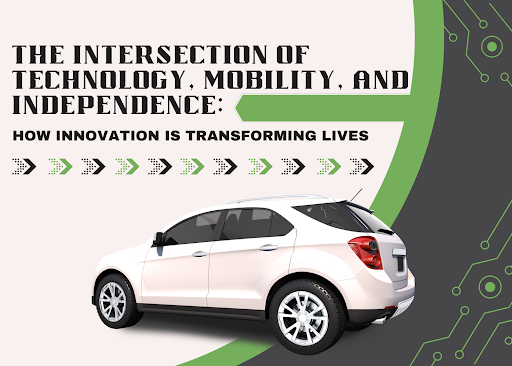
Imagine a world where every door opens with ease, every street is a path to possibility, and every decision about where you go and how you get there is yours to make. For people with disabilities, technology, mobility, and personal independence are no longer distant hopes, but a reality that is fast approaching. In this blog, we’ll explore how innovations in adaptive technology and mobility are reshaping personal freedom, offering real-life solutions, and empowering individuals to move beyond limitations.
The Technology Behind the Wheel
For many individuals with disabilities, the car has long been a symbol of independence. Yet, for some, driving hasn’t always felt accessible—until now. Advances in adaptive driving technology have transformed the once-daunting task of driving into an empowering experience. Devices like hand controls, left-foot accelerators, and spinner knobs are allowing people to take the wheel once again, driving confidently and safely.
But it’s not just about getting from point A to point B. Modern cars come equipped with driver-assist features such as lane-assist, automatic braking, and even self-parking. These innovations aren’t just “nice-to-haves”—they play a crucial role in making driving more accessible and safe, especially for individuals who have challenges with mobility or dexterity. Technology isn’t simply augmenting the driving experience—it’s reshaping it.
Reimagining Mobility and Personal Independence with Technology
Mobility is not just about the physical act of moving—it’s about having the freedom to explore, engage with the world, and live independently. For individuals with disabilities, technology is transforming how we think about mobility. Powered wheelchairs, adaptive vehicles, and AI-driven tools are breaking down barriers, turning what once seemed out of reach into a reality. Whether it’s taking a road trip, attending a family gathering, or running errands, the ability to drive—or even access reliable transportation—is a powerful form of independence.
Technology doesn’t just help people move; it empowers them to make decisions, take control of their environment, and predict their needs. From adaptive equipment tailored to personal needs to smart homes that anticipate daily tasks, technology is enabling individuals with disabilities to live with greater autonomy. It’s not just about navigating physical space—it’s about navigating life with confidence and choice, making these advancements vital in the pursuit of personal independence.
Building a More Inclusive Future
While technology has brought us to an exciting point, the journey is far from over. Innovations in adaptive technology are happening at lightning speed, and each new development brings us closer to an entirely inclusive world where mobility is a right, not a privilege.
The challenge now lies in how we continue to make these technologies accessible and affordable, ensuring that people with disabilities aren’t left behind as new solutions emerge. We must continue to advocate for the inclusion of adaptive features in mainstream products, increase public awareness, and break down the societal barriers that still exist.
Everyone has a role to play in building a more inclusive future. Advocating for accessible technologies can start with small, everyday actions. This could include supporting policies and companies that prioritize inclusivity, raising awareness about the challenges faced by individuals with disabilities, or participating in community efforts that promote universal design. Educating others, volunteering for organizations that focus on disability rights, and even using social media to share resources and stories can make a tangible impact. By amplifying voices and stories of those who face mobility challenges, we can inspire change and drive progress toward a world where everyone has equal access to the tools that enable them to thrive.
Conclusion: Embracing the Future Together
As we stand at the crossroads of technology, mobility, and personal independence, the future for individuals with disabilities is filled with possibility. This evolving landscape promises a world where driving isn’t a privilege reserved for a few, but a right for everyone. With the power of technology, individuals can take control of their journey, embracing mobility and freedom on their own terms.
At Driving to Independence, we’re proud to be part of this transformative movement. Our mission is to support individuals with disabilities as they gain confidence behind the wheel. Whether it’s through adaptive driving assessments or personalized training, we’re here to guide you toward achieving greater mobility, independence, and the freedom to explore life’s road ahead.
Ready to explore how adaptive driving technology can open new doors for you? Contact Driving to Independence today to get started on your journey toward more freedom, mobility, and independence.
